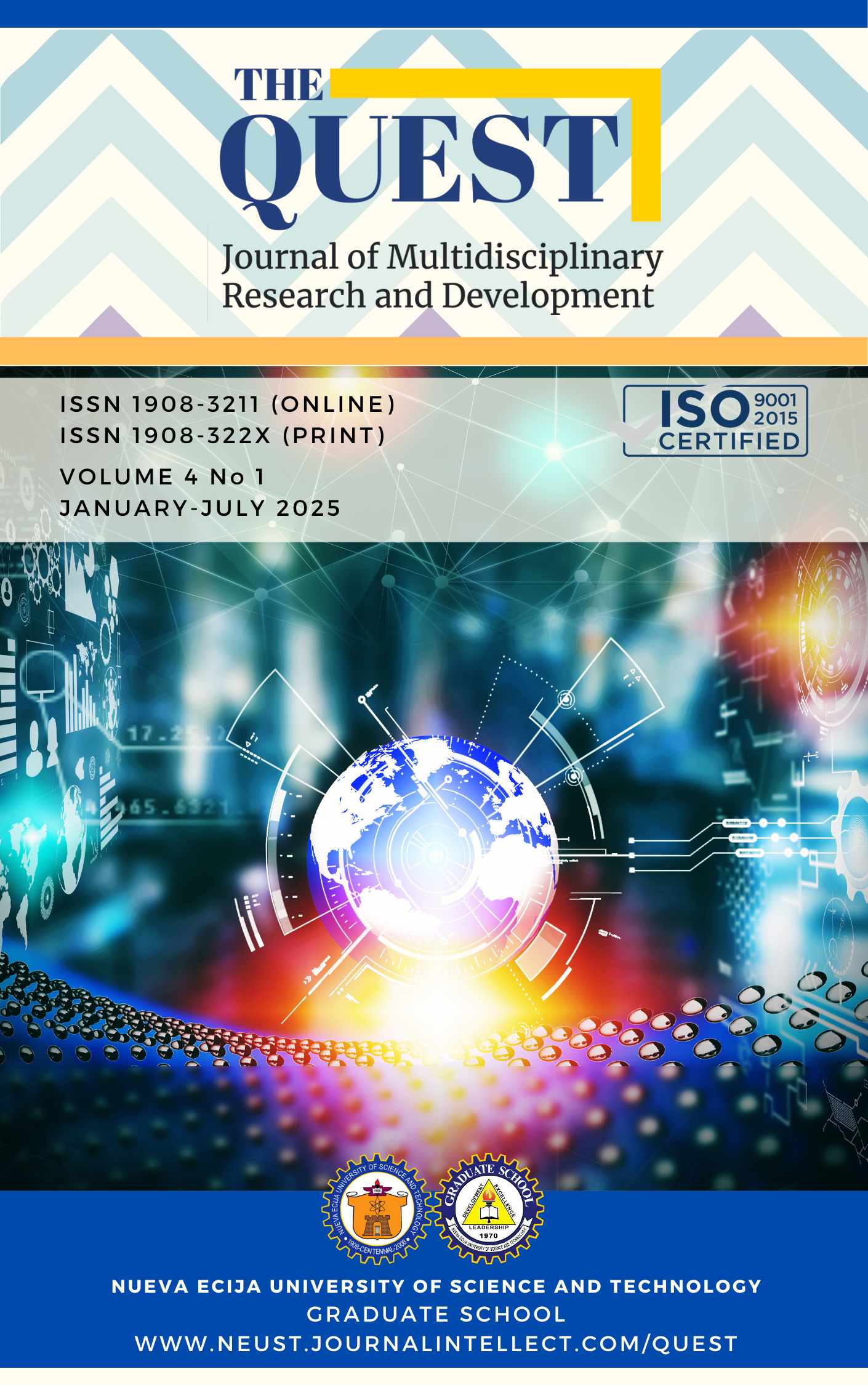The Impact of AI and IoT-Based Smart Classrooms: A Data-Driven Approach to Business Intelligence in Education

Published 07/25/2025
Keywords
- Smart Classrooms,
- Internet of Things (IoT),
- Artificial Intelligence (AI),
- Education,
- Data-Driven Decision-Making
How to Cite
Copyright (c) 2025 The QUEST: Journal of Multidisciplinary Research and Development

This work is licensed under a Creative Commons Attribution-NonCommercial 4.0 International License.
Abstract
The rise of the Artificial Intelligence (AI) and Internet of Things (IoT) in education is transforming the learning process, especially within the framework of Education 4.0. This research explores how smart classrooms, supported by artificial intelligence (AI) and the Internet of Things (IoT), are viewed as enhancing student engagement, optimizing the use of school resources, and enabling more prompt academic decisions. The research was conducted in a private higher education institution in Pampanga, involving 22 respondents including students, faculty, and administrators familiar with smart classroom technologies. Using a validated survey, the results show how useful and effective these technologies are in the classroom. Respondents liked that IoT makes learning a more interactive and resource-efficient experience, with AI identified as supporting personalized instruction and possible improvement in student outcomes. Concerns about data privacy, infrastructure costs, and the learning curve for faculty were raised, but the general feeling is strongly in favor of adopting smart classroom tools. This study provides useful insights for educators, school leaders, tech developers, leaders and policymakers who want to improve the learning experience. It also highlights the need for ongoing support through training, reliable infrastructure, and clear policies to effectively use these technologies in education.
References
- Alshammari, M., & Korr, J. (2022). The effectiveness of smart classroom technologies in enhancing student engagement and interactivity. International Journal of Educational Technology in Higher Education, 15-30.
- Domingo, E. K., Cruz, J. N., Mallari, M. O., & Florencondia, N. T. (2025). Assessing the Influence of Transformational and Transactional Leadership Styles on the Academic Performance of Engineering Students. International Journal of Progressive Research in Science and Engineering, 189-192.
- Esteban, A. P., Piad, K., Tano, I., Espino, J., Lagman, A., Victoriano, J., & Mababa, J. (2024, September). Implementation of Digital Governance in the Philippine SUCs: Basis for an Enterprise-Level Information System Model. In 2024 6th International Workshop on Artificial Intelligence and Education (WAIE) (pp. 374-378). IEEE.
- Fernando, J. G., Endaya, M. J., Mallari, M. O., & Cuison, L. T. (2022). The Efficacy of A Third-Party Enterprise System in State Universitiesand Colleges (SUC) Setting. Journal of Positive School Psychology, 7773–7780.
- Gunasekaran, D. S., Gnanakumar, P., Jinda, T., Kadu, R. K., K, A. I., & Nayak, D. C. (2024). Digital Transformation Of Classroom; Impact of AI And Iot In The Educational Sector. Educational Administration: Theory and Practice, 13461-13469.
- Hossain, M. U., & Cummings, J. (2023). Challenges in implementing smart classroom technologies: A systematic review. Educational Technology Research and Development, 71(1), 35-57.
- Huang, Y., & Lin, C. (2023). Personalized learning in smart classrooms: Opportunities and challenges. Journal of Computer Assisted Learning, 39 (2), 271-283.
- Khadka, R., & Mahapatra, S. (2021). Smart classrooms as a tool for optimizing resource utilization in educational institutions. Education and Information Technologies, 26 (4), 4533-4550.
- Kumar, P. D. S. K. V., Perera, L. W. R. S., & Jayasekara, K. A. D. A. K. B. (2020). Big data in education: Data-driven decision making. International Journal of Educational Management, 34 (4), 735-746.
- Nanda, D. W., Pujari, D. B., & Kothari, V. S. (2021). Education 4.0: Redesigning the role of technology in higher education. International Journal of Innovative Technology and Exploring Engineering (IJITEE), 10 (1), 97-100.
- Nilo, M. j., Dungca, E. J., Mallari, M. O., & Florencondia, N. T. (2025). Leadership Dynamics: A Comparative Study of Public Sector and Academic Setting. Iconic Research and Engineering Journals | , 317-326.
- Ogallo, G. G. (2018). IoT - Enhancing Data-Driven Decision-Making in Higher Education. Case Study of Ohio University. Ohio, USA.
- Santos, J. V., Ramos, L., & Mallari, M. O. (2025). Assessment of Facility Management Performance: A Basis for Digitalizing Reporting Systems in Educational Institutions. Journal of Interdisciplinary Perspectives, 14-21.
- Ve, D., Soundarraj, D. P., Morwani, D. H., Jani, D. J., Pathak, D., & Pal, S. (2024). Digital Transformation of Classroom; Impact of AI and IOT in Educational Sector. Journal of Informatics Education and Research, 1114-1119.
